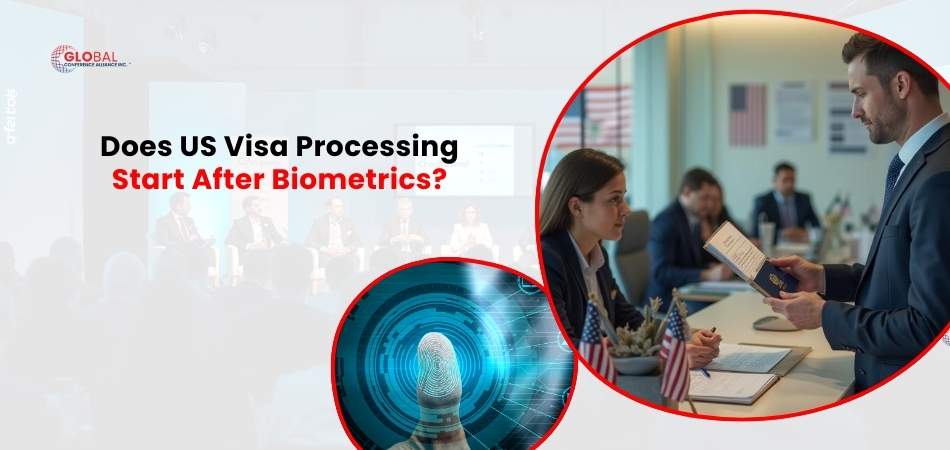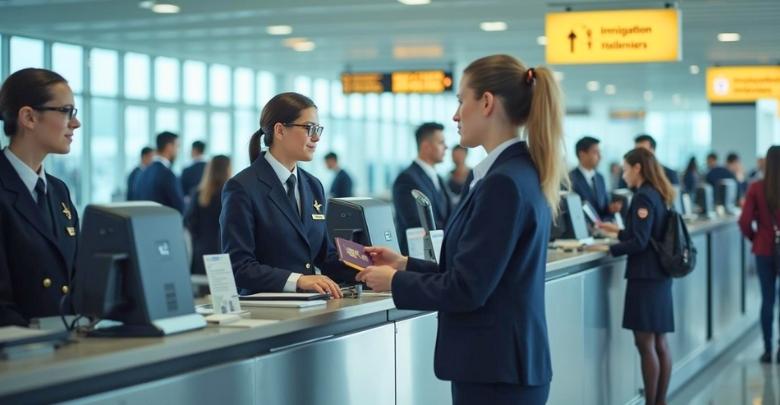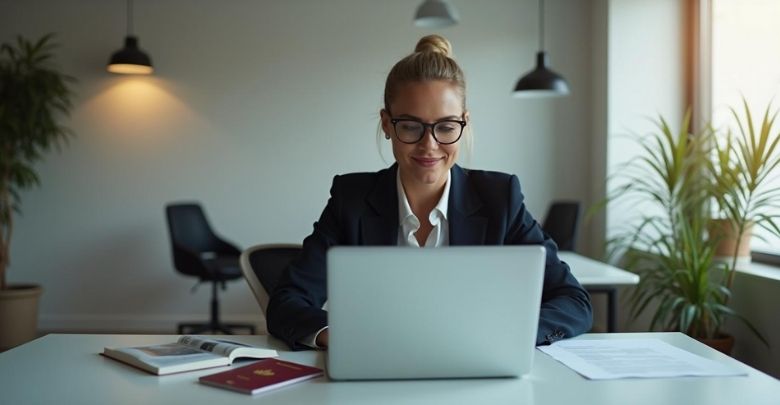A US visa application involves several steps to verify your eligibility, and biometrics play an essential role in this process. Many applicants often wonder, does US visa processing start after biometrics?
Yes, US visa processing starts after biometrics are collected. Biometrics, such as fingerprints and photographs, are used to assess your application and verify your identity. This step ensures that the information provided matches the records and allows the authorities to evaluate the application.
We will guide you through the entire visa processing timeline and provide tips to make your experience as smooth as possible. Read on to learn what to expect after you submit your biometrics.
Does US Visa Processing Start After Biometrics?
Yes, US visa processing begins after biometrics are collected. Once your fingerprints and photograph are taken, the application review begins. This step is essential for verifying your identity and ensuring all submitted information is accurate.

Biometrics help US authorities check your records against security databases to identify any risks. This process confirms that your details match the provided documents. Without completing biometrics, your visa application cannot move forward to the next stage.
After biometrics, the processing time may vary depending on the visa type and application load. Delays can happen due to background checks or document reviews. Staying updated on your application status is important during this waiting period.
For those planning to attend upcoming conferences in USA, timely visa processing is crucial. Make sure you complete all required steps, including biometrics. This helps avoid delays and increases your chance of receiving your visa on time.
Types of Biometrics Are Collected During the US Visa Application Process
When applying for a US visa, biometrics play an important role. These details are collected to ensure your identity is verified. Different types of biometrics are gathered during the process to help authorities assess your eligibility. The following is a list of biometric types with detailed explanations:
Fingerprints Collection
The most common type of biometrics collected is your fingerprints. These prints are taken to confirm your identity and check your background. The collected fingerprints are sent to security databases for screening. This helps authorities look for any past criminal activities or immigration violations.
The fingerprinting process is done digitally and typically takes only a few minutes. This method ensures accuracy and helps prevent any fraud. Fingerprints provide a specific identification that matches only to you. They are compared to databases to ensure no prior issues exist.
Photograph Capture
Another key biometric collected during the process is a digital photograph. This photograph helps US authorities confirm your identity with ease. The image is used to match the visa on your passport with your physical appearance. A clear and accurate photograph is essential for this step.
The photograph, which is part of the biometrics information for USA visas, will be taken at the biometric appointment or Visa Application Center. It must adhere to specific guidelines, including requirements for the background and facial expression. This ensures there is no confusion about your identity during the visa process, as the photo becomes part of your application records.
Signature Collection
Your signature is also a part of the biometrics process. This is required to confirm your application and validate your consent. The signature is digitally captured and added to your records. It acts as your authorization for the visa application process.
The signature provides an extra layer of verification for your identity. It ensures that the application is genuinely submitted by you. This step also helps authenticate documents during the approval process. Your signature helps confirm that the details you provided are accurate and authorized.
Are Biometrics the Only Factor Considered in US Visa Decision-making?
No, biometrics are not the only factor considered in the US visa decision-making process. While biometrics help verify your identity, other factors also play a key role. These include your application forms, supporting documents, and interview performance.
Your financial status is another important aspect reviewed by US authorities. They want to ensure you can support yourself during your stay. Proof of ties to your home country, such as a job or family, is also critical.
The purpose of your trip is another major factor considered. If you are attending a conference or business event, that helps strengthen your application. Make sure you provide details that align with your visa category.
US authorities also review your background during the application process. Criminal history, prior visa violations, or immigration issues are all factors that can influence their decision. Biometrics helps in this area by cross-referencing your information with security databases.
Consequences of Missing a Biometrics Appointment for a Us Visa
Missing a biometrics appointment for a US visa can lead to various consequences that may delay or derail your application. Make sure to attend all scheduled appointments to avoid complications. Here’s what happens if you miss your biometrics appointment:
- Application Delay: Failure to attend biometrics can delay your visa application. Authorities need biometrics to verify your identity and process your case.
- Increased Processing Time: Without biometrics, your application cannot be processed efficiently. This leads to longer waiting times for approval or rejection.
- Potential Denial of Visa: If you miss your biometrics appointment, your visa request may be denied. Missing this step could be seen as incomplete.
- Automatic Rescheduling: Sometimes, missed appointments are automatically rescheduled. However, the new appointment may still result in delays in your application process.
- No Application Consideration: Your application will not be considered without completing biometrics. It is an essential step in the visa process.
- Impact on Future Applications: Missing an appointment could negatively affect future visa applications. Authorities may view this as a lack of seriousness.
- Missed Opportunity for Urgent Processing: If you miss your biometrics appointment, urgent processing might no longer be available. This can result in unnecessary delays.
- Additional Costs for Rescheduling: If you miss the appointment, rescheduling may incur extra fees. You could be required to pay for an additional appointment.
- Ineligibility for Interviews: Without biometrics, you may not be eligible for a visa interview. Interviews are part of the visa approval process.
- Difficulty Tracking Application Status: Tracking your application status becomes harder if biometrics are missing. This complicates any updates or changes to your visa request.
Time Frame for US Visa Processing After Biometrics Are Collected
After your biometrics are collected for a US visa, the processing time varies based on several factors. The time frame depends on the type of visa, your background, and application volume. Here’s an overview of the processing time after biometrics are collected.
Standard Processing Time
For most US visa applications, processing takes 7 to 15 business days after biometrics are collected. However, it can take longer depending on specific circumstances. Background checks and security assessments may add extra time. The consulate or embassy will notify you once the decision is made.
Background Checks and Security Reviews
After biometrics, the visa application undergoes background checks. These checks ensure you have no security or criminal issues. Depending on the applicant’s history, these checks may take longer. Some cases may experience delays, especially with complex backgrounds.
High Demand and Application Volume
During peak application seasons, processing times may increase. High demand can cause longer waiting times for all applicants. Visa processing offices may experience delays, impacting your application timeline. It’s important to apply well in advance during busy periods to avoid issues.
Delays Due to Missing Documents
If any required documents are missing or incomplete, it can delay processing. You may be asked to provide additional information or clarifications. This can slow down the overall review process. Always ensure your documents are complete and correct before submitting them.
Expedited Processing Requests
In certain situations, you may request expedited processing. This allows your visa application to be processed faster than the usual time frame. However, expedited requests are not always guaranteed. Only specific emergencies or circumstances qualify for this type of processing.
Interview Scheduling and Results
After biometrics, some visa types may require an interview. Scheduling an interview can sometimes add to the processing time. The results of the interview can further affect your visa decision. Be prepared for possible delays if an interview is required.
Best Way to Stay Informed During Visa Processing After Biometrics
A smooth visa process begins after biometrics, so staying informed is crucial. By keeping track of your application, you can reduce uncertainty and avoid delays. Here’s how you can stay updated and manage the process effectively.
Check Visa Application Status Online
Many US embassies offer an online tracking system for visa applications. You can use this to check the status regularly. The status will indicate if there’s a request for additional documents or actions. It’s a great way to stay informed about your visa’s progress.
Monitor Your Email for Updates
Once biometrics are collected, the consulate or embassy will send updates via email. Keep an eye on your inbox for any new messages. Emails may include requests for further information or interview schedules. Stay responsive to emails to avoid delays in the processing time.
Use the Visa Application Center (VAC) Portal
Visa Application Centers offer portals to track your visa’s status after biometrics. Logging in will allow you to view updates or changes. You should regularly check for new updates regarding your application. Some VACs also allow you to schedule appointments or provide additional documents.
Stay in Contact with Your Local US Embassy
For any issues or clarifications, contact the US embassy or consulate handling your application. You can get in touch to ask about the status and how to proceed after biometrics. Ensure you follow the proper communication channels provided by the embassy. Avoid contacting them too frequently unless necessary.
Join Online Visa Forums or Communities
Many applicants share experiences on online forums dedicated to visa processing. Joining these communities can help you understand the typical processing time. These forums can offer valuable advice about potential delays and common issues. It’s important to verify information and not solely rely on online discussions.
Prepare for Possible Delays
Sometimes, processing times can extend due to various factors. Be aware that high application volumes or background checks may cause delays. Always prepare for these possibilities by applying well in advance. This way, you won’t be caught off guard during the waiting period.
Keeping yourself informed during your visa processing is key to ensuring everything goes smoothly. Keep track of updates, be proactive, and know the next steps after biometrics in US visa processing to avoid unnecessary stress.
Frequently Asked Questions (FAQs)
Besides the basic steps to apply for a US visa, you may have a lot of questions. Listed below are answers to commonly asked questions about what happens after biometrics are collected, helping you to understand the process in full.
Can I Leave the Country While Waiting for My US Visa Approval?
It is not recommended to leave the country while your visa is being processed, especially if you need to attend an interview. Leaving during this time could complicate your application. If you must travel, consult with the consulate or embassy to understand how it might impact your application.
What Happens if I Need to Reschedule My Biometrics Appointment?
If you need to reschedule your biometrics appointment, you must do so through the appropriate system. Most US visa processing centers allow rescheduling, but you may face delays. Rescheduling may also incur additional fees depending on the policies of the embassy or consulate.
Can I Apply for US Visa While Waiting for a Decision on a Previous Application?
You cannot apply for a new US visa while a previous application is still being processed. It is important to wait for the final decision on your current application before starting a new one. This ensures that both applications do not interfere with each other.
How Do I Know if My Biometrics Have Been Successfully Recorded?
After your biometrics appointment, you should receive a confirmation that your fingerprints and photograph were successfully recorded. You can track the status of your application through the official visa application portal. If there are any issues, the processing center will notify you.
Can I Apply for US Visa if I Have Had a Previous Visa Denial?
A previous visa denial does not automatically disqualify you from reapplying. However, you will need to provide strong documentation explaining why your previous application was denied. Biometrics will still be collected, and the authorities will review all factors carefully before making a decision.
Final Thoughts
Knowing what happens after biometrics helps ensure a smoother US visa application process. Completing biometrics is a crucial step in verifying your identity and advancing your application. Without it, your visa processing cannot move forward.
Now, to address an important question: Does US visa processing start after biometrics? Yes, it does. After biometrics are collected, authorities begin reviewing your application and conducting necessary checks. By taking this step, you can ensure your information is accurate and in line with security records.
Therefore, you should stay proactive throughout the process by tracking your application status regularly. Any missing documents or missed appointments can delay your visa approval. Being informed and staying on top of each step helps you get your visa approved faster.







